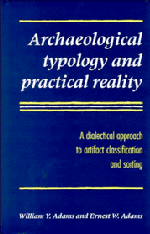 Archaeological Typology and Practical Reality
Archaeological Typology and Practical Reality Published online by Cambridge University Press: 23 November 2009
In previous chapters we have considered a number of factors, theoretical as well as practical, that influence the development of classificatory systems. We are now ready to discuss the different kinds of classifications, typologies, and taxonomies that archaeologists actually make and use, and the reasons why they differ one from another. We will begin by re-emphasizing certain basic structural distinctions that affect many different kinds of classifications. We will then go on to consider some specific kinds of classifications that archaeologists make for different purposes. Finally we will discuss some additional, practical considerations that are unrelated to purpose, but that may result in variation from one classification to another.
Basic structural distinctions
Classification and typology. We indicated in Chapter 4 that, according to our usage, a classification is any contrasting set of categories into which a specific body of material may be subdivided, or partitioned. A typology is a particular kind of classification; one designed for the sorting of entities into categories that are absolutely mutually exclusive. The practical importance of this distinction will appear when we discuss the differences between artifact classifications, which are nearly always typologies, and “culture” classifications, which are not.
Typology and taxonomy. A basic typology has only one level of abstraction or generalization; all of its member types are considered to be equivalent in this respect (see Chapter 7).
To save this book to your Kindle, first ensure [email protected] is added to your Approved Personal Document E-mail List under your Personal Document Settings on the Manage Your Content and Devices page of your Amazon account. Then enter the ‘name’ part of your Kindle email address below. Find out more about saving to your Kindle.
Note you can select to save to either the @free.kindle.com or @kindle.com variations. ‘@free.kindle.com’ emails are free but can only be saved to your device when it is connected to wi-fi. ‘@kindle.com’ emails can be delivered even when you are not connected to wi-fi, but note that service fees apply.
Find out more about the Kindle Personal Document Service.
To save content items to your account, please confirm that you agree to abide by our usage policies. If this is the first time you use this feature, you will be asked to authorise Cambridge Core to connect with your account. Find out more about saving content to Dropbox.
To save content items to your account, please confirm that you agree to abide by our usage policies. If this is the first time you use this feature, you will be asked to authorise Cambridge Core to connect with your account. Find out more about saving content to Google Drive.